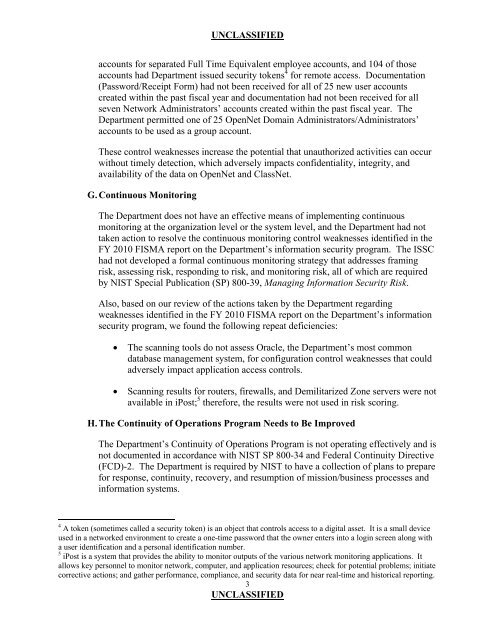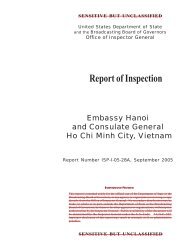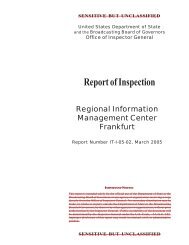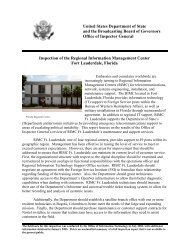Evaluation of Department of State Information Security Program ...
Evaluation of Department of State Information Security Program ...
Evaluation of Department of State Information Security Program ...
Create successful ePaper yourself
Turn your PDF publications into a flip-book with our unique Google optimized e-Paper software.
UNCLASSIFIED<br />
accounts for separated Full Time Equivalent employee accounts, and 104 <strong>of</strong> those<br />
accounts had <strong>Department</strong> issued security tokens 4 for remote access. Documentation<br />
(Password/Receipt Form) had not been received for all <strong>of</strong> 25 new user accounts<br />
created within the past fiscal year and documentation had not been received for all<br />
seven Network Administrators’ accounts created within the past fiscal year. The<br />
<strong>Department</strong> permitted one <strong>of</strong> 25 OpenNet Domain Administrators/Administrators’<br />
accounts to be used as a group account.<br />
These control weaknesses increase the potential that unauthorized activities can occur<br />
without timely detection, which adversely impacts confidentiality, integrity, and<br />
availability <strong>of</strong> the data on OpenNet and ClassNet.<br />
G. Continuous Monitoring<br />
The <strong>Department</strong> does not have an effective means <strong>of</strong> implementing continuous<br />
monitoring at the organization level or the system level, and the <strong>Department</strong> had not<br />
taken action to resolve the continuous monitoring control weaknesses identified in the<br />
FY 2010 FISMA report on the <strong>Department</strong>’s information security program. The ISSC<br />
had not developed a formal continuous monitoring strategy that addresses framing<br />
risk, assessing risk, responding to risk, and monitoring risk, all <strong>of</strong> which are required<br />
by NIST Special Publication (SP) 800-39, Managing <strong>Information</strong> <strong>Security</strong> Risk.<br />
Also, based on our review <strong>of</strong> the actions taken by the <strong>Department</strong> regarding<br />
weaknesses identified in the FY 2010 FISMA report on the <strong>Department</strong>’s information<br />
security program, we found the following repeat deficiencies:<br />
� The scanning tools do not assess Oracle, the <strong>Department</strong>’s most common<br />
database management system, for configuration control weaknesses that could<br />
adversely impact application access controls.<br />
� Scanning results for routers, firewalls, and Demilitarized Zone servers were not<br />
available in iPost; 5 therefore, the results were not used in risk scoring.<br />
H. The Continuity <strong>of</strong> Operations <strong>Program</strong> Needs to Be Improved<br />
The <strong>Department</strong>’s Continuity <strong>of</strong> Operations <strong>Program</strong> is not operating effectively and is<br />
not documented in accordance with NIST SP 800-34 and Federal Continuity Directive<br />
(FCD)-2. The <strong>Department</strong> is required by NIST to have a collection <strong>of</strong> plans to prepare<br />
for response, continuity, recovery, and resumption <strong>of</strong> mission/business processes and<br />
information systems.<br />
4 A token (sometimes called a security token) is an object that controls access to a digital asset. It is a small device<br />
used in a networked environment to create a one-time password that the owner enters into a login screen along with<br />
a user identification and a personal identification number.<br />
5 iPost is a system that provides the ability to monitor outputs <strong>of</strong> the various network monitoring applications. It<br />
allows key personnel to monitor network, computer, and application resources; check for potential problems; initiate<br />
corrective actions; and gather performance, compliance, and security data for near real-time and historical reporting.<br />
3<br />
UNCLASSIFIED








